Your Name was Makoto Shinkai’s 2016 anime movie hit. No other anime movie since the legendary Studio Ghibli 2001 film Spirited Away achieved such high commercial and critical success, whether domestically in Japan or in the United States. While Shinkai was already a renowned director in Japan at this point, praised for his stunning visuals and coordination of emotionally driven music, no previous film of his was such a breakout success as Your Name was.
With Shinkai’s next film, Weathering With You (Tenki no Ko) set to release in just a little less than a week (July 19th) in Japan, it’s worth looking at what made Your Name so unique in the hopes that Shinkai can recreate that magic with Weathering With You.
Similar, But Different
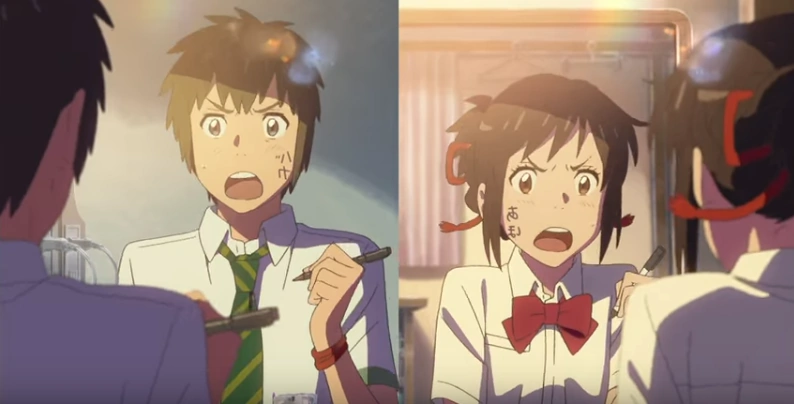
Your Name is similar, visually, thematically, or otherwise, to Shinkai’s 2007 film 5 Centimeters per Second (Byōsoku Go Senchimētoru) (to be abbreviated: 5 cm/s). Thematically, Your Name and 5 cm/s deal with the same principle of distance, whether physical or otherwise, between two lovers, and both explore how it impacts their relationship. 5 cm/s does this in a lot more literal of a sense, exploring how the physical distance between two people slowly drove them personally apart. 5 cm/s is much more grounded, as the story is entirely believable and realistic.
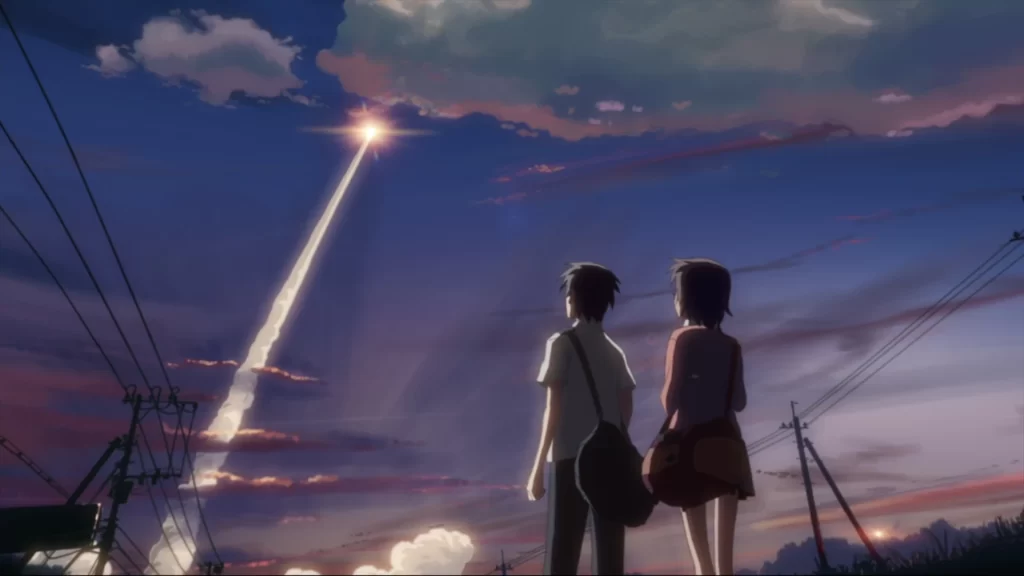
Image Credit: Makoto Shinkai/CoMix Wave Films/Toho
Themes aside, as films 5 cm/s and Your Name come together quite differently as well. Perhaps the first important cinematographic difference between the two films is the structure. Structurally, five cm/s is much less of a cohesive film than Your Name. This is a direct result of how Shinkai chose to tell the story of 5 cm/s versus Your Name. 5 cm/s is separated into three twenty-minute-long “episodes” that come together (or based on promotional material for the film, “chain” together) to tell an overarching story. As a result of this methodology, five cm/s is quite literally more episodic than Your Name, and the space between the episodes is significant time skips, with many events or elements of the characterization being left in the space in between. Due to this format, the audience often has to play “catch up,” and the audience receives only what the characters choose to recount in the space in between.
The episodic nature of 5 cm/s is a stark contrast to the structure of Your Name. Your Name is, as is more traditionally done, told as a singular story with events directly having a cause and effect not only on each other, but more directly contributing to the overarching plot. This results in a feeling of interconnectedness. By employing this more standard structure, the audience viewing the movie perceives themselves as being part of the movie, as opposed to helplessly watching events unfold, as is the case with 5 cm/s. The structuring of either film plays a massive role in their respective pacing, in which case another contrast is apparent.
5 cm/s is an incredibly slow-paced film, not only in terms of literal story movement but also from a cinematographic view as well. In terms of plot progression, each ‘episode’ of 5 cm/s take place within a somewhat short span of time, relying on the skips between each episode to progress the timeline. For example, the first episode of 5 cm/s, Cherry Blossom, establishes the two main characters, Takaki and Akari, and their relationship that grows in elementary school. Yet, that span of time doesn’t comprise the bulk of the episode. The first episode primarily centers around a time when Takaki and Akari have both graduated elementary school, but because Akari and her family have moved, and Takaki and his family plan on moving to the literal other side of Japan, they decide to meet each other one last time. Unfortunately, Takaki’s train gets perpetually delayed on his way to visit Akari, and their time visiting each other is forced to be cut short. And that’s the bulk of the first episode. A span of a mere few hours characterized by people moving at an egregiously slow pace, primarily due to factors out of their control, all contribute to the overall pace of 5 cm/s. And after the first episode’s conclusion, the second episode starts, but a massive amount of time has passed since the first, as Takaki is now in his final year of high school.
This stands in stark contrast to Your Name, where periods of time are continually moved forward throughout, and it’s common for a matter of weeks or days to pass by in the span of a few real-world minutes. For example, as the two main characters of Your Name Taki and Mitsuha have to quickly adapt to living in each other’s bodies and ways of life, the movie quickly shows days upon days passing by, as the two of them reach conclusions about what may be happening to each other, as well as filling them in on events in their lives that happened as their bodies were swapped, and it all happens in the span of around five real-world minutes. Not only have significant plot points been opened or explored during this time, but time has progressed plotwise almost on the scale of weeks during this period as well. This creates the effect on the audience that they’re being taken along with Taki and Mitsuha, on their journey, instead of helplessly watching the events of 5 cm/s unfold. Ultimately this leads to more audience engagement with Your Name.
Technical Pacing



Image Credit: Makoto Shinkai/CoMix Wave Films
Cinematographically, the difference in pacing between Your Name and 5 cm/s is also apparent. In 5cm/s, the characters are very slow moving, and the camera shots are very slow as well, whether it be slow pans or follows, or even slow cuts. Many of the still shots in 5 cm/s often only depict one or two things moving within the scene at a time, or sometimes the subjects of the frame will be completely still as the camera slowly zooms out, and some sort of narration plays. By comparison to Your Name, the shots often have a lot of moving parts, with multiple movements of characters or objects all occurring within the same shot, as well as a fast pace of cuts to keep things flowing forward. The character’s movements of Your Name are also often more frantic than those of 5 cm/s. Yet, Your Name’s fast pace is also varied within itself. Despite, as a whole, seems to be constantly moving forward, Your Name is capable of completely pausing the pace to almost a standstill to have an emotionally impactful moment, for example: when Taki and Mitsuha meet each other on the crater ridge near the end of the film. Your Name is also capable of operating in the space between “rapidly forward” and “almost completely still,” as it provides a contrast in pacing just moving between Mitsuha and Taki’s lives.
Due to living in the massive urban sprawl of modern-day Tokyo, Taki’s life is portrayed as a lot more fast-paced. From scene to scene, Taki is almost always in a different place and always has something to do. Oftentimes, he’s even speaking about the other things he has to do later that day (such as going to work). When examining his counterpart, Mitsuha, who lives in the rural setting of Itomori, she is moving slower than Taki. Mitsuha’s day-to-day routine is a lot more leisurely than Taki’s. For example, Mitsuha and her friends are often portrayed doing many of the same activities, and even acknowledging how boring and slow it is, desiring a faster life like Taki’s. Finally, the last factor contributing to the pacing of both films is the soundtrack.
Contrasting Sounds
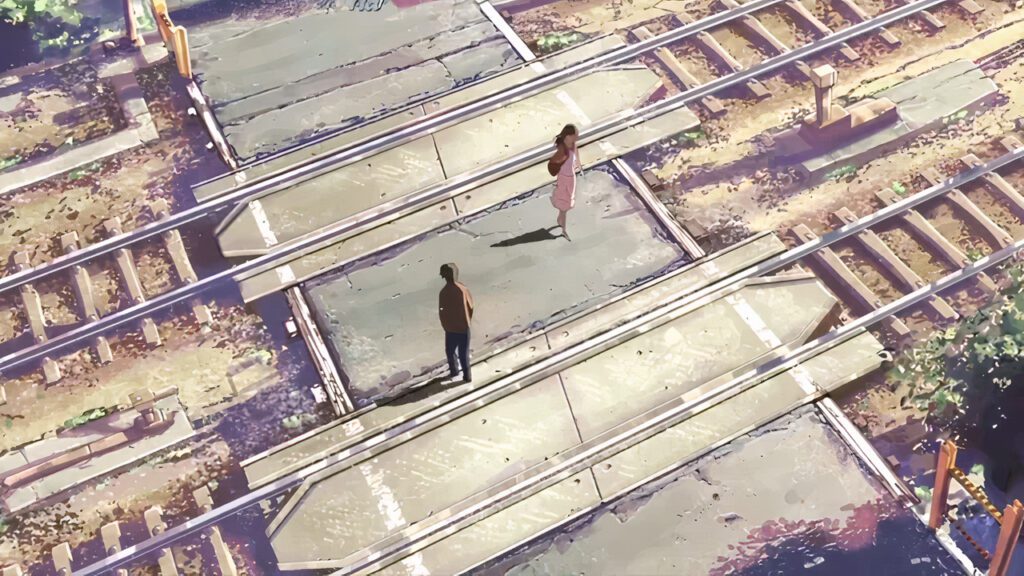


Image Credit: Makoto Shinkai/CoMix Wave Films/Toho
5 cm/s has one primary instrument, and that is the piano. To match the film’s pace, 5 cm/s ‘s soundtrack is composed of primarily piano-based, soft, slow, and somber melodies. The songs aren’t necessarily out of place but are quite similar sounding, especially when played in the background of the movie. There is not a lot of diversity within the soundtrack. Much like the pacing, it contrasts to Your Name, which is once again capable of hitting many points in between slow and fast to better match what’s happening on screen. Your Name mixes the somber piano tones with a more lively and upbeat guitar and even switches into full-on lyrical pop at certain points. Your Name, being capable of switching pacing, is capable of switching its music to match the situation or pacing. A happy song will play when Your Name wants the audience to feel happy. A sad song will play when sad, as opposed to the consistently sorrowful soundtrack for 5 cm/s. The music further grabs the audience into Your Name.
Your Name mixes the somber piano tones with a more lively and upbeat guitar and even switches into full-on lyrical pop at certain points.
More to the soundtrack of Your Name, the audience begins associating certain songs or sounds with certain characters through repetition. And oftentimes, throughout the film, this is used to spark an emotional reaction the audience may have already associated. For example, during Taki and Ms. Okudera’s first date, the song “Date” plays during the sequence. Overall, it is a simple, slow, and methodical piano piece, rarely diversifying or having a lead into a greater piece of music or harmony. Within the piece, there are some sparks or hints of more things to be characterized by the entrance of violins or the odd cello, but they never come to fruition. The audience may attribute certain things to hearing this melody, like searching for love when there are some hints or whispers of it. Later on in the film, near the end, a different song plays, titled “Theme of Mitsuha”. “Theme of Mitsuha” ‘s first half mirrors “Date” ‘s melody almost exactly, as if to evoke the same sense of searching the audience may have associated with the song. Yet, “Theme of Mitsuha” resolves itself musically into a greater, warmer melody, as if to speak to the love between Taki and Mitsuha resolving, and not being left to the wayside or missing.
Visually Massive



Image Credit: Makoto Shinkai/CoMix Wave Films
One noticeably absent aspect of cinematography missing in 5 cm/s is a massive set piece. The closest thing in 5 cm/s is the Japanese space rocket launch in the second episode, Cosmonaut. This prop comes out of nowhere and literally pauses Takaki and Kanae’s conversation. The rocket is only shown once, and it’s only used as a visual piece for that particular moment in the film. Even when examining the promotional art for 5 cm/s, the rocket is never featured. Your Name provides a spectacle of a set piece in the form of the comet “Tiamat”, and Tiamat, although technically being the movie’s antagonist, is featured multiple times throughout the film, as well as having a significant presence in almost every piece of promotional material for Your Name. Because of this, Tiamat becomes iconic to Your Name, providing the audience with at the very least, a massive spectacle to remember the movie by. Put quite simply, Your Name takes advantage of being a movie, that is, being projected on a seventy by thirty-foot space; a projection screen at a theatre.
Finally, Your Name is a clear departure from Shinkai’s past works. As aforementioned, 5 cm/s’ pacing is very slow, even by normal movie standards. Yet, that’s not exclusive to just that particular film. Save for Your Name, all of Shinkai’s past works not discussed had a similarly slow pace, and they were all capped off with an almost iconic ending style: abrupt and unsatisfying. 5 cm/s provides one of the best examples, with the film concluding by depicting Takaki just resigning himself to his love lost, the distance between him and Akari finally becoming too far to bear. The setup, and even the events of the ending scene of 5 cm/s, all lead the audience to believe that something will come next, that the story will have some sort of ending that provides closure. But Shinkai doesn’t provide that, instead the camera cuts and the credits begin to roll. The audience is left wanting more. This is in contrast to Your Name, where the journey of Taki and Mitsuha comes to a satisfying end. Taki and Mitsuha were able to overcome the distance between them, able to fully realize the love that grew for each other. Your Name provides a conclusion that leaves audiences with a sense of completion.

While both films explore distance, Your Name clearly had a key influence as to what drove the distance between Taki and Mitsuha, and this influence showing its head in Your Name provided Japanese audiences with a particularly resonating impact. The comet Tiamat in Your Name is certainly a larger-than-life event and results in destruction reminiscent of disaster and chaos. Despite never directly acknowledging it in interviews or commentaries, it is almost undeniable that a series of larger than life disasters inspired Shinkai’s drivers of conflict in Your Name.
Distance Through Disaster
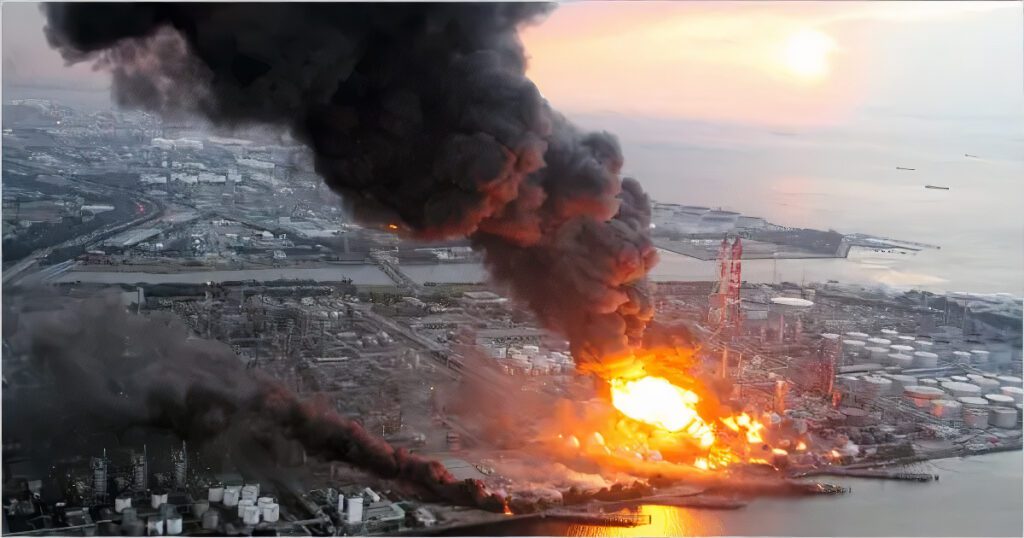


Sendai Nippon Oil Refinery and surroundings after 3/11 disaster. Image Credit: United States Navy
On March 11th, 2011 a magnitude 9.1 earthquake occurred approximately 51 miles east of the Japanese mainland. The earthquake resulted in massive tsunami waves with a maximum recorded height of 130 feet. Due to the destruction left by the earthquake and subsequent tsunamis, the Fukushima Daiichi nuclear power plant incurred three meltdowns in respective reactors rated at a level 7 event scale by IAEA standards. At the end of this chain reaction of disasters, the death toll stands at 15,897, with 6,157 injured and 2,533 people missing. Your Name released five short years after the 3-11 disaster and has several striking parallels in its portrayal of events to the disaster itself.
Perhaps the first most striking similarity is the struggle Mitsuha faces to get Itomori’s mayor to evacuate the town. In the original timeline, he never evacuated, and even in the to be changed timeline, despite having warnings to do so, he was still hesitant to evacuate (it could even be argued that he never actually gave an evacuation order, despite Mitsuha’s pleas, and the townsfolk of Itomori evacuated based on believing Mitsuha). This plot point in Your Name is scarily similar to the events that occurred in the small town of Okawa. Despite warnings to evacuate and/or move to higher ground, an elementary school in Okawa held 75 of its students obeying the Board of Education’s emergency protocols that did not have Okawa listed as in danger of a tsunami under normal circumstances. Due to holding the children, all 75 students and associated teachers were killed due to the tsunami.
Past the evacuation disaster, the ‘collective amnesia’ present in Your Name’s populace is also relevant. As previously mentioned, Your Name depicts the urban/rural divide between Tokyo and Itomori. Despite only three years after the Tiamat disaster, no one in Tokyo seems to remember (or care) that an entire town and 500 people got wiped out. All too engrossed with their constantly moving lives and other distractions to remember. If they remember the event, it would be from their experience of watching the magnificent comet pass by overhead, much like Taki is shown to have experienced in the film.
Finally, the other notable parallel is the lack of effort to rebuild Itomori. When Taki and his friends eventually come across the destroyed town three years later, they see not only the destruction but ‘caution tape’ around the entrance to the town. Inked onto the tape is “Reconstruction.” Yet, three years later as the audience sees it from Taki’s perspective, no efforts appear to have been started to reconstruct Itomori, and it has simply fallen from memory. This would appear to be reminiscent of the countless rural towns wiped out by the 3-11 disaster, left to be forgotten.
Looking Ahead


Your Name explores the same themes and motifs as Shinkai’s past works but does it on a much grander scale, presenting itself more cohesively and enjoyably. Because of this, not only is a non-Japanese audience able to find meaning and enjoyment in Taki and Mitsuha’s journey, but to a Japanese audience, the reminiscence of the 3-11 disaster no doubt struck a powerful chord. Your Name truly has something for everyone, and this is no doubt the reason why it achieved such success both domestically in Japan, and other regions as well.
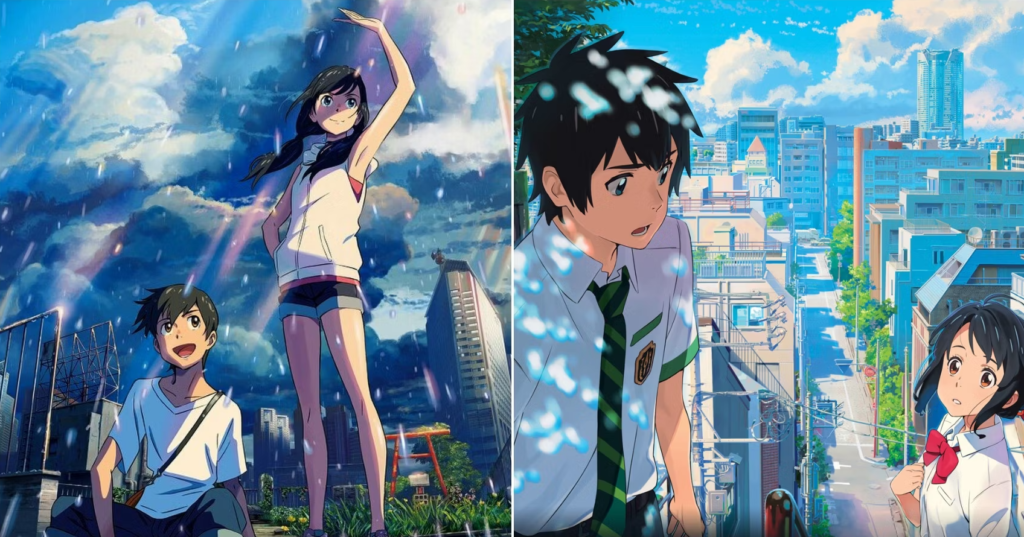
We can only wait for Weathering With You to come to the United States and the rest of the world, and I hope to see similar themes present there as well. Once it becomes watchable in the US, I hope to also provide an analysis of that film.
Thank you for reading. Check out my piece on Initial D here if you’d like to read more anime retrospectives. And you can check out the primary trailer for Weathering With You and a brief showcase of Shinkai’s past works here.













